Comprehensive Hydrological Analysis of the Buha River Watershed with High-Resolution SHUD Modeling
Abstract
:1. Introduction
2. Data and Methods
2.1. Study Area
2.2. Data
| Data | Description | Variables | Source |
|---|---|---|---|
| Elevation | 30 m | Elevation | ASTER GDEM [24] |
| Watershed Boundary | Vector polygon | Boundary | Generated from DEM delineation |
| River Network | Vector polylines | River reaches | Generated from DEM delineation |
| Landcover | 500 m resolution | Land cover classes | USGS MODIS land cover data [26] |
| Soil | 1 km resolution | Sand-silt-clay percentage, bulk density, organic matter | HWSD [25] |
| Meteorological Data | 0.1 deg, 3 h interval | Precipitation, temperature, humidity, wind speed, radiation, pressure | CMFD [28] |
| Streamflow | - | Streamflow at gauge station of Buha River | Local hydrological department |
2.3. Model Construction
2.3.1. SHUD Model
- Snow accumulation and melt: Snow accumulation is computed using a temperature threshold-based rain–snow partitioning scheme, while snowmelt is calculated using a degree-day model.
- Evapotranspiration (ET): The model initially calculates potential evapotranspiration (PET) of forcing time-series data using the Penman–Monteith equation. Actual evapotranspiration for each triangular unit is then determined by multiplying PET by a soil moisture stress coefficient, which is derived from the soil moisture content in the unit.
- River and surface runoff routing: Both are computed using the Manning equation, though with notably different parameters for each.
- Infiltration, unsaturated and saturated flow: The calculation of these processes is governed by the Darcy–Richards equation, where hydraulic conductivity is the determinant parameter.
2.3.2. Model Configuration
2.3.3. Model Parameter Calibration
- Initialization of the CMA-ES algorithm.
- Random sampling parameter sets (]) within a predefined parameter range.
- Conduct parallel simulation tasks using these parameter sets.
- Upon completion of parallel simulations, compare simulation results with observational data and compute the best objective function value in this generation. Computation ceases if the best objective function value exceeds a preset threshold () or if the maximum number of iterations has been reached (). Continue otherwise.
- Select the most optimal parameter set based on the objective function value to seed the next generation of parameter sampling (). Introduce additional perturbation based on the covariance of parameters and result, repeat random sampling within parameter space to generate new parameter sets.
- Repeat steps (3) to (5).
3. Results
3.1. Evaluation of CMFD Data
3.2. Evaluation of SHUD Model
3.3. River Hydrological Balance
3.4. Water Balance
3.5. Snowfall
4. Discussion
- (1)
- Data-driven uncertainty: While the CMFD data offer high temporal and spatial resolution and cover the entire study area, thereby representing a valuable data source for numerical hydrological simulation, a comparison of the grid data with corresponding site data reveals a reasonable agreement at monthly and annual scales. However, a substantial deviation is encountered at the daily scale, especially for the precipitation data. This introduces uncertainty when the SHUD model is driven with sub-daily scale data, leading to less reliable daily streamflow and other variables on a daily scale. Therefore, our analysis primarily relies on monthly and yearly hydrological data.
- (2)
- Model structure uncertainty on frozen soil: There are permafrost and frozen soil within this area which affect the hydrological processes in the watershed [42]. The frozen soil parameterization in the SHUD model is indeed based on the nonlinear response of hydraulic properties to accumulated temperature, drawing from simplified permafrost frost index algorithms as noted in [42,43,44]. Specifically, the key parameter of hydraulic conductivity decreases with falling accumulated temperatures (below zero), significantly impacting both lateral and vertical water flows across each triangular unit within the model domain. These effects cumulatively influence the hydrographic characteristics and the streamflow of the watershed at the basin scale. However, as rightly pointed out, this approach does not fully capture the coupled heat–water physical processes. Addressing this issue is a crucial direction for the future development of the SHUD model. So, prospective integration of advanced models that feature coupled water and heat dynamics is needed to provide a more comprehensive treatment of water–heat–vegetation interactions.
- (3)
- Parameter uncertainty: Despite employing the Covariance Matrix Adaptation Evolution Strategy (CMA-ES) for automatic calibration, which is efficient and can find the global optimum, multiple parameter sets show acceptable performance, exhibiting the “equifinality” phenomenon [45,46,47,48]. This indicates that parameter uncertainty still exists. Future simulations and analyses for this watershed should consider employing multi-parameter ensemble simulations for a more comprehensive investigation of the resulting uncertainty.
5. Conclusions
- The monthly datasets from CMFD align accurately with observed data, although there is a lack of precision in reflecting daily precipitation intensity characteristics. A slight deviation has been observed in temperature and relative humidity over various time scales. Over the past four decades, an ascending trend in precipitation and temperature in the Buha River watershed has been observed, despite the absence of a significant abrupt change.
- The SHUD model exhibits promising accuracy on a monthly scale when fitting observed streamflow data, demonstrating its applicability to hydrological forecasts and water resource management within the Buha River watershed.
- Runoff ratios for the Buha River are low, fluctuating annually between 0.11 and 0.21. Notably, fluctuations in the runoff ratios around 2007 are closely related to the turning point in the Qinghai Lake stage from a downward to an upward trend.
- Within the analysis of water balance in river channels, leakage and replenishment along the river show spatial alteration, with a net leakage over long-term periods. However, no perceptible spatial difference has been observed between leakage and replenishment.
- In the Buha River watershed, snow accumulation increases with altitude, and in most years, the accumulated snow completely melts within the same year. On a seasonal scale, the increase in streamflow coincides with the onset of snowmelt, making a significant contribution to streamflow replenishment at the end of cold seasons.
Author Contributions
Funding
Data Availability Statement
Acknowledgments
Conflicts of Interest
References
- Zhang, H. Analysis of Changes in Hydrological Elements of Lakes on the Qinghai-Tibet Plateau Based on Remote Sensing and Their Response to Climate Change. Ph.D. Thesis, Liaocheng University, Liaocheng, China, 2018. [Google Scholar]
- Li, X.; Zhang, T.; Yang, D.; Wang, G.; He, Z.; Li, L. Research on lake water level and its response to watershed climate change in Qinghai Lake from 1961 to 2019. Front. Environ. Sci. 2023, 11, 1130443. [Google Scholar] [CrossRef]
- Li, L.; Shen, H.; Liu, C.; Xiao, R. Response of water level fluctuation to climate warming and wetting scenarios and its mechanism on Qinghai Lake. Clim. Chang. Res. 2020, 16, 600–608. [Google Scholar]
- Lanzhou Branch of Chinese Academy of Sciences. Environmental Evolution and Prediction in Qinghai Lake; Science Press: Beijing, China, 1994. (In Chinese) [Google Scholar]
- Cui, B.; Li, X. Runoff processes in the Qinghai Lake Basin, Northeast Qinghai-Tibet Plateau, China: Insights from stable isotope and hydrochemistry. Quat. Int. 2015, 380–381, 123–132. [Google Scholar] [CrossRef]
- Cui, B.; Li, X. The impact of climate changes on water level of Qinghai Lake in China over the past 50 years. Hydrol. Res. 2016, 47, 532–542. [Google Scholar] [CrossRef]
- Shu, L.; Li, X.; Chang, Y.; Meng, X.; Chen, H.; Qi, Y.; Wang, H.; Li, Z.; Lyu, S. Advancing understanding of lake–watershed hydrology: A fully coupled numerical model illustrated by Qinghai Lake. Hydrol. Earth Syst. Sci. 2024, 28, 1477–1491. [Google Scholar] [CrossRef]
- Qin, Q.; Huang, Q. Simulation of energy and water budget of Qinghai Lake, China. Chin. J. Oceanol. Limnol. 1998, 16, 289–297. [Google Scholar]
- Li, X.; Xu, H.; Sun, Y.; Zhang, D.; Yang, Z. Lake-level change and water balance analysis at lake Qinghai, West China during recent decades. Water Resour. Manag. 2007, 21, 1505–1516. [Google Scholar] [CrossRef]
- Li, X.; Xiao, J.; Li, F.; Xiao, R.; Xu, W.; Wang, L. Remote Sensing Monitoring of the Qinghai Lake Based on EOS/MODIS Data in Recent 10 Years. J. Nat. Resour. 2012, 27, 1962–1970. [Google Scholar]
- Li, X.; Zhao, H.; Wang, G.; Yao, K.; Xin, Q.; He, Z.; Li, L. Influence of watershed hydrothermal conditions and vegetation status on lake level of Qinghai Lake. Arid Land Geogr. 2019, 42, 499–508. [Google Scholar]
- Shi, X.; Li, L.; Wang, Q.; Liu, B.; Zhang, H.; Liu, Z. Climatic Change and Its Influence on Water Level of Qinghai Lake. Meteorol. Sci. Technol. 2005, 33, 58–62. [Google Scholar]
- Fang, J.; Li, G.; Rubinato, M.; Ma, G.; Zhou, J.; Jia, G.; Yu, X.; Wang, H. Analysis of Long-Term Water Level Variations in Qinghai Lake in China. Water 2019, 11, 2136. [Google Scholar] [CrossRef]
- Dong, H.; Song, Y.; Zhang, M. Hydrological trend of qinghai lake over the last 60 years: Driven by climate variations or human activities? J. Water Clim. Chang. 2019, 10, 524–534. [Google Scholar] [CrossRef]
- Zhang, C.; He, L.; Wang, L. Climate Evolution Characteristics of Water Resources in Buha River Basin. South North Water Transf. Water Sci. Technol. 2017, 15, 45–49+57. [Google Scholar]
- Li, Y.; Li, X.; Cui, B.; Peng, H.; Yi, W. Trend of streamflow in Lake Qinghai basin during the past 51 years (1956–2007)—Take Buha River and Shaliu River for examples. J. Lake Sci. 2010, 22, 757–766. [Google Scholar]
- Zhang, N. Study on the Variation of Runoff in Buha River. Qinghai Sci. Technol. 2002, 36–38. (In Chinese) [Google Scholar]
- Huang, X.; Li, R.; Gan, Y.; Wu, Y. Attribution analysis of runoff change in Buha River basin based on Budyko hypothesis. South North Water Transf. Water Sci. Technol. 2023, 21, 480–490, (In Both Chinese and English). [Google Scholar]
- Zhou, Y.; Chen, H.; Zhang, S.; Huang, Y. Simulating the influence of climate change on hydrological proceses at Buha River basin of Qinghai Lake by SWIM. J. Beijing Norm. Univ. 2017, 53, 208–214. [Google Scholar] [CrossRef]
- Wang, H.; Li, D.; Lei, Y.; Zhang, M. Application of Topmodel in Runoff Simulation in Buha River Basin. Water Conserv. Sci. Technol. Econ. 2016, 22, 8–12. [Google Scholar]
- Long, Y.; Zhang, Y.; Zhao, G.; Yan, P.; Li, Q.; Li, R. The Uncertainty in Meteorological and Hydrological Proceses Modeled by Using SWAT Model—A Case Study in the Buhachu River Basin. J. Glaciol. Geocryol. 2012, 34, 660–667. [Google Scholar]
- Zhang, G.; Xie, H.; Yao, T.; Li, H.; Duan, S. Quantitative water resources assessment of Qinghai Lake basin using Snowmelt Runoff Model (SRM). J. Hydrol. 2014, 519, 976–987. [Google Scholar] [CrossRef]
- Su, D.; Wen, L.; Gao, X.; Leppäranta, M.; Song, X.; Shi, Q.; Kirillin, G. Effects of the Largest Lake of the Tibetan Plateau on the Regional Climate. J. Geophys. Res. Atmos. 2020, 125, e2020JD033396. [Google Scholar] [CrossRef]
- NASA; METI; AIST; Japan Spacesystems; U.S./Japan ASTER Science Team. ASTER Global Digital Elevation Model V003. 2018. Available online: https://lpdaac.usgs.gov/products/astgtmv003/ (accessed on 1 July 2024).
- Nachtergaele, F.; van Velthuizen, H.; Verelst, L.; Batjes, N.; Dijkshoorn, J.; van Engelen, V.; Fischer, G.; Jones, A.; Montanarella, L.; Petri, M.; et al. Harmonized World Soil Database (Version 1.2); Food and Agric Organization of the UN (FAO): Rome, Italy; International Institute for Applied Systems Analysis (IIASA): Laxenburg, Austria; ISRIC—World Soil Information: Wageningen, The Netherlands; Inst of Soil Science-Chinese Acad of Sciences (ISS-CAS): Nanjing, China; EC-Joint Research Centre (JRC): Brussels, Belgium, 2008. [Google Scholar]
- Broxton, P.D.; Zeng, X.; Sulla-Menashe, D.; Troch, P.A. A Global Land Cover Climatology Using MODIS Data. J. Appl. Meteorol. Climatol. 2014, 53, 1593–1605. [Google Scholar] [CrossRef]
- Shu, L.; Ullrich, P.; Meng, X.; Duffy, C.; Chen, H.; Li, Z. rSHUD v2.0: Advancing the Simulator for Hydrologic Unstructured Domains and unstructured hydrological modeling in the R environment. Geosci. Model Dev. 2024, 17, 497–527. [Google Scholar] [CrossRef]
- He, J.; Yang, K.; Tang, W.; Lu, H.; Qin, J.; Chen, Y.; Li, X. The first high-resolution meteorological forcing dataset for land process studies over China. Sci. Data 2020, 7, 25. [Google Scholar] [CrossRef] [PubMed]
- Freeze, R.; Harlan, R. Blueprint for a physically-based, digitally-simulated hydrologic response model. J. Hydrol. 1969, 9, 237–258. [Google Scholar] [CrossRef]
- Hrachowitz, M.; Clark, M.P. HESS Opinions: The complementary merits of competing modelling philosophies in hydrology. Hydrol. Earth Syst. Sci. 2017, 21, 3953–3973. [Google Scholar] [CrossRef]
- Shu, L.; Chang, Y.; Wang, J.; Chen, H.; Li, Z.; Zhao, L.; Meng, X. A brief review of numerical distributed hydrological model SHUD. Adv. Earth Sci. 2022, 37, 680–691. [Google Scholar]
- Shu, L.; Chen, H.; Meng, X.; Chang, Y.; Hu, L.; Wang, W.; Shu, L.; Yu, X.; Duffy, C.; Yao, Y.; et al. A review of integrated surface-subsurface numerical hydrological models. Sci. China Earth Sci. 2024, 67, 1459–1479. [Google Scholar] [CrossRef]
- Shu, L.; Ullrich, P.A.; Duffy, C.J. Simulator for Hydrologic Unstructured Domains (SHUD v1.0): Numerical modeling of watershed hydrology with the finite volume method. Geosci. Model Dev. 2020, 13, 2743–2762. [Google Scholar] [CrossRef]
- Shu, L. Impacts of Urbanization and Climate Change on the Hydrological Cycle: A Study in Modern and Ancient Land Use Change. Ph.D. Thesis, The Pennsylvnia State University, University Park, PA, USA, 2017. [Google Scholar]
- Shu, L.; Chang, Y. Model and data for “Comprehensive Hydrological Analysis of the Buha River Watershed with High-Resolution SHUD Modeling”. In Comprehensive Hydrological Analysis of the Buha River Watershed with High-Resolution SHUD Modeling (v0.1); Zenodo: Geneva, Switzerland, 2024. [Google Scholar] [CrossRef]
- Hansen, N. The CMA Evolution Strategy: A Comparing Review. In Towards a New Evolutionary Computation; Springer: Berlin/Heidelberg, Germany, 2016; pp. 75–102. [Google Scholar] [CrossRef]
- Gupta, H.V.; Kling, H.; Yilmaz, K.K.; Martinez, G.F. Decomposition of the mean squared error and NSE performance criteria: Implications for improving hydrological modelling. J. Hydrol. 2009, 377, 80–91. [Google Scholar] [CrossRef]
- Li, X.; Long, D.; Slater, L.J.; Moulds, S.; Shahid, M.; Han, P.; Zhao, F. Soil Moisture to Runoff (SM2R): A Data-Driven Model for Runoff Estimation Across Poorly Gauged Asian Water Towers Based on Soil Moisture Dynamics. Water Resour. Res. 2023, 59, 1169–1188. [Google Scholar] [CrossRef]
- Santhi, C.; Arnold, J.G.; Williams, J.R.; Dugas, W.A.; Srinivasan, R.; Hauck, L.M. Validation of the SWAT Model on a Large River Basin with Point and Nonpoint Sources. JAWRA J. Am. Water Resour. Assoc. 2001, 37, 1169–1188. [Google Scholar] [CrossRef]
- Moriasi, D.N.; Arnold, J.G.; Van Liew, M.W.; Bingner, R.L.; Harmel, R.D.; Veith, T.L. Model Evaluation Guidelines for Systematic Quantification of Accuracy in Watershed Simulations. Trans. ASABE 2007, 50, 885–900. [Google Scholar] [CrossRef]
- Moriasi, D.N.; Gitau, M.W.; Pai, N.; Daggupati, P. Hydrologic and water quality models: Performance measures and evaluation criteria. Trans. ASABE 2015, 58, 1763–1785. [Google Scholar] [CrossRef]
- Gao, H.; Wang, J.; Yang, Y.; Pan, X.; Ding, Y.; Duan, Z. Permafrost Hydrology of the Qinghai-Tibet Plateau: A Review of Processes and Modeling. Front. Earth Sci. 2021, 8, 576838. [Google Scholar] [CrossRef]
- Nelson, F.E.; Outcalt, S.I. A Computational Method for Prediction and Regionalization of Permafrost. Arct. Alp. Res. 1987, 19, 279–288. [Google Scholar] [CrossRef]
- Walvoord, M.A.; Kurylyk, B.L. Hydrologic Impacts of Thawing Permafrost—A Review. Vadose Zone J. 2016, 15, 1–20. [Google Scholar] [CrossRef]
- Ebel, B.A.; Loague, K. Physics-based hydrologic-response simulation: Seeing through the fog of equifinality. Hydrol. Process. 2006, 20, 2887–2900. [Google Scholar] [CrossRef]
- Beven, K. Towards an alternative blueprint for a physically based digitally simulated hydrologic response modelling system. Hydrol. Process. 2002, 16, 189–206. [Google Scholar] [CrossRef]
- Beven, K. A manifesto for the equifinality thesis. J. Hydrol. 2006, 320, 18–36. [Google Scholar] [CrossRef]
- Savenije, H.H. Equifinality, a blessing in disguise? Hydrol. Process. 2001, 15, 2835–2838. [Google Scholar] [CrossRef]
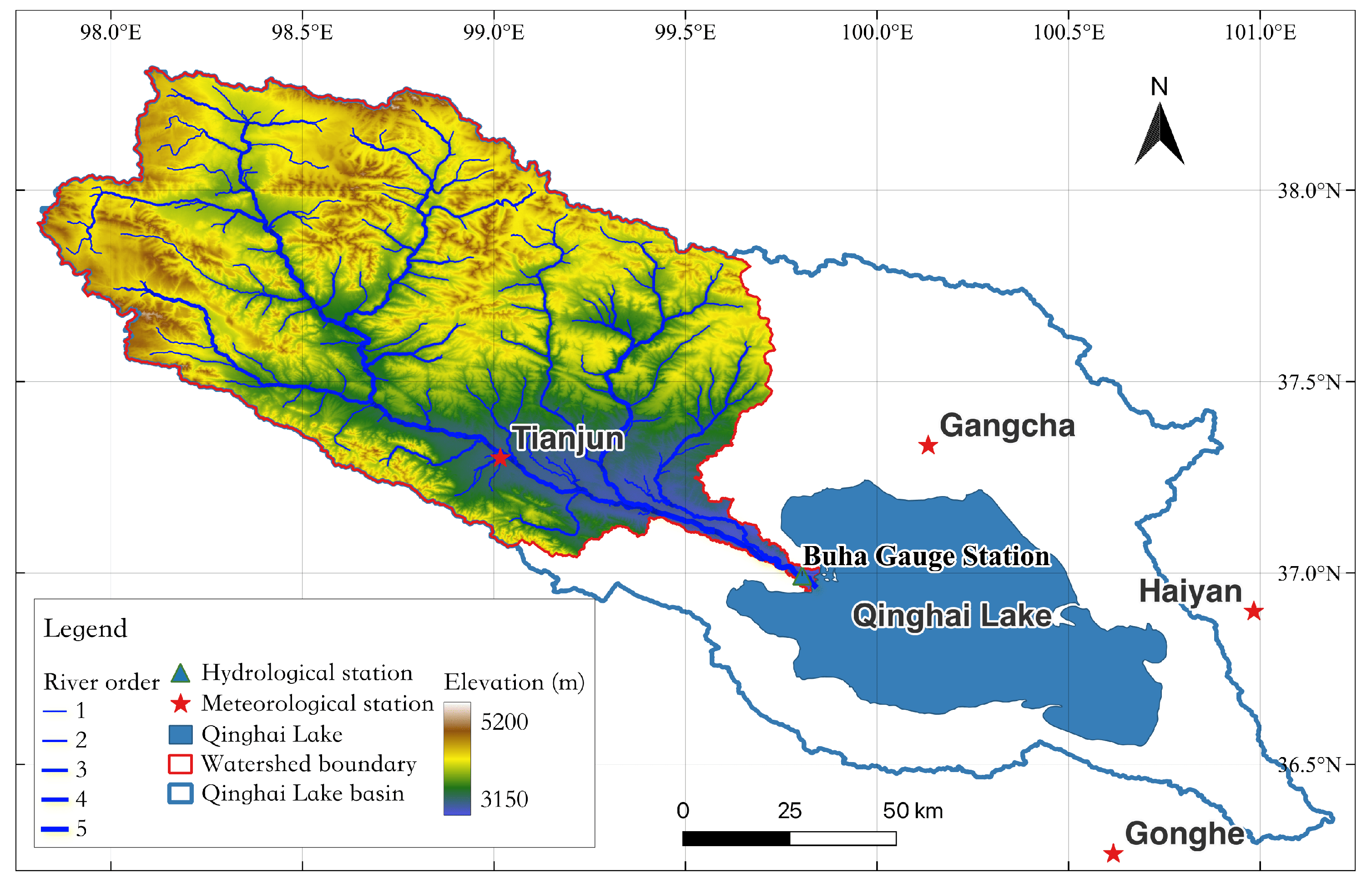
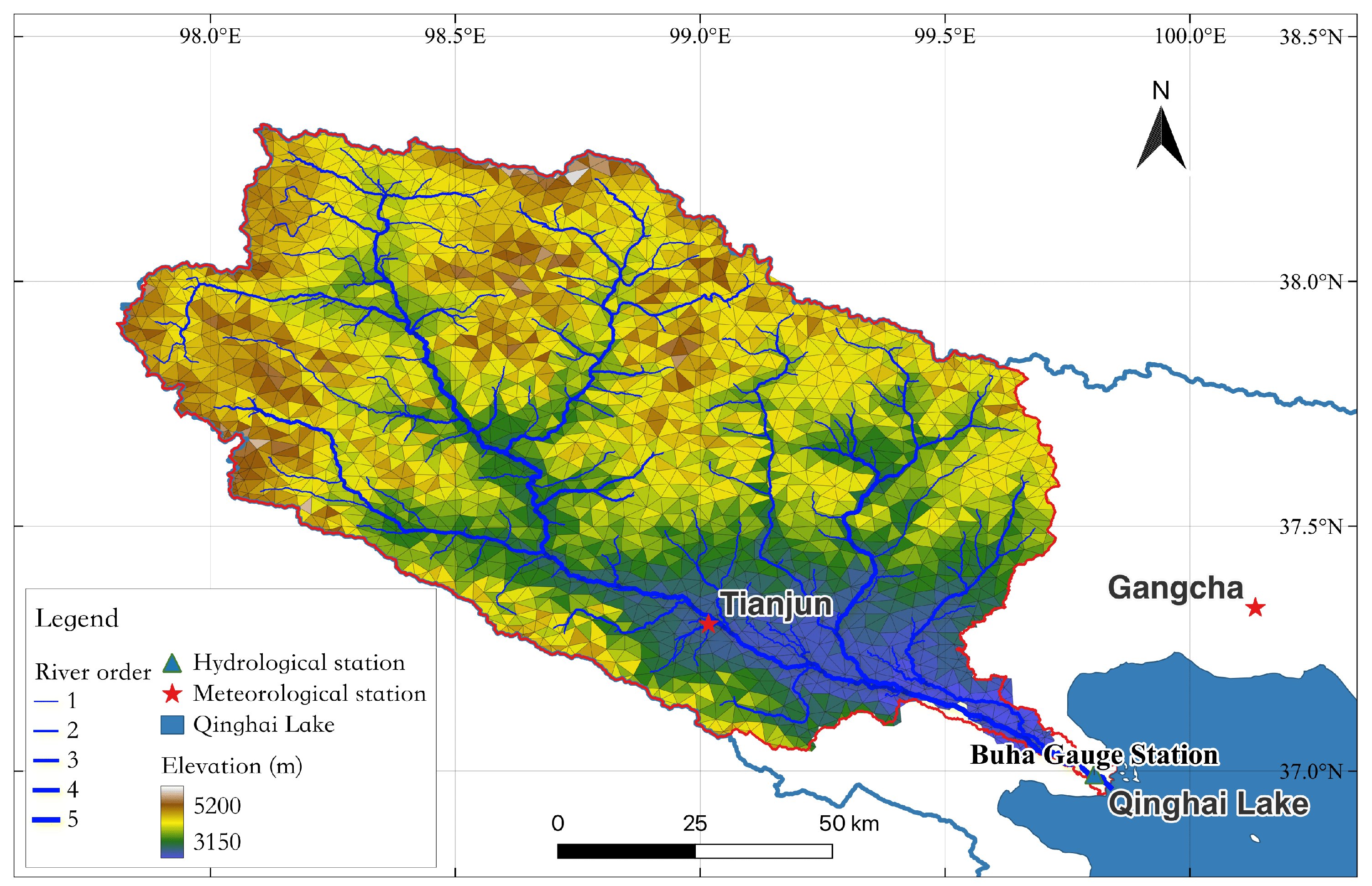
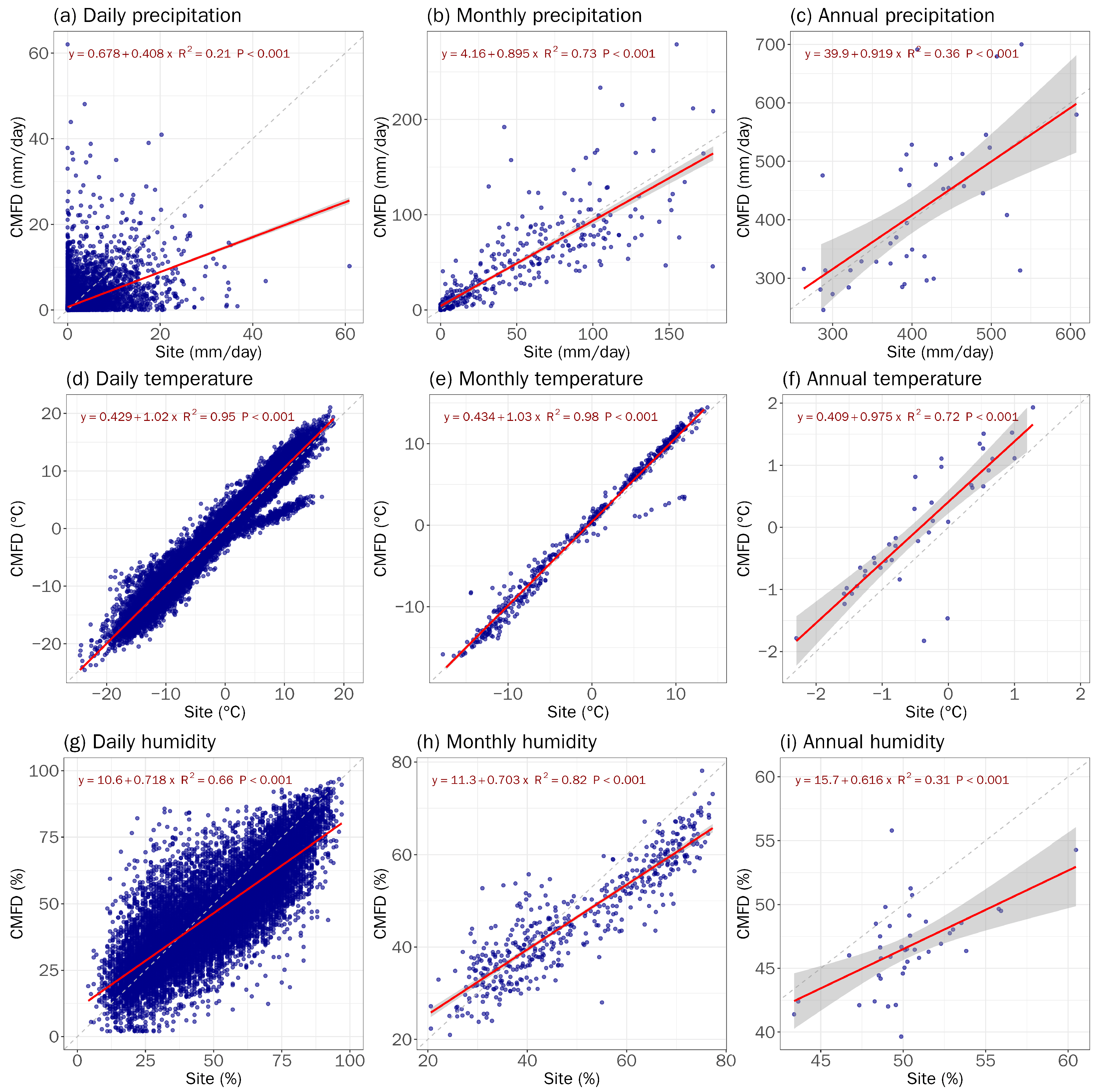


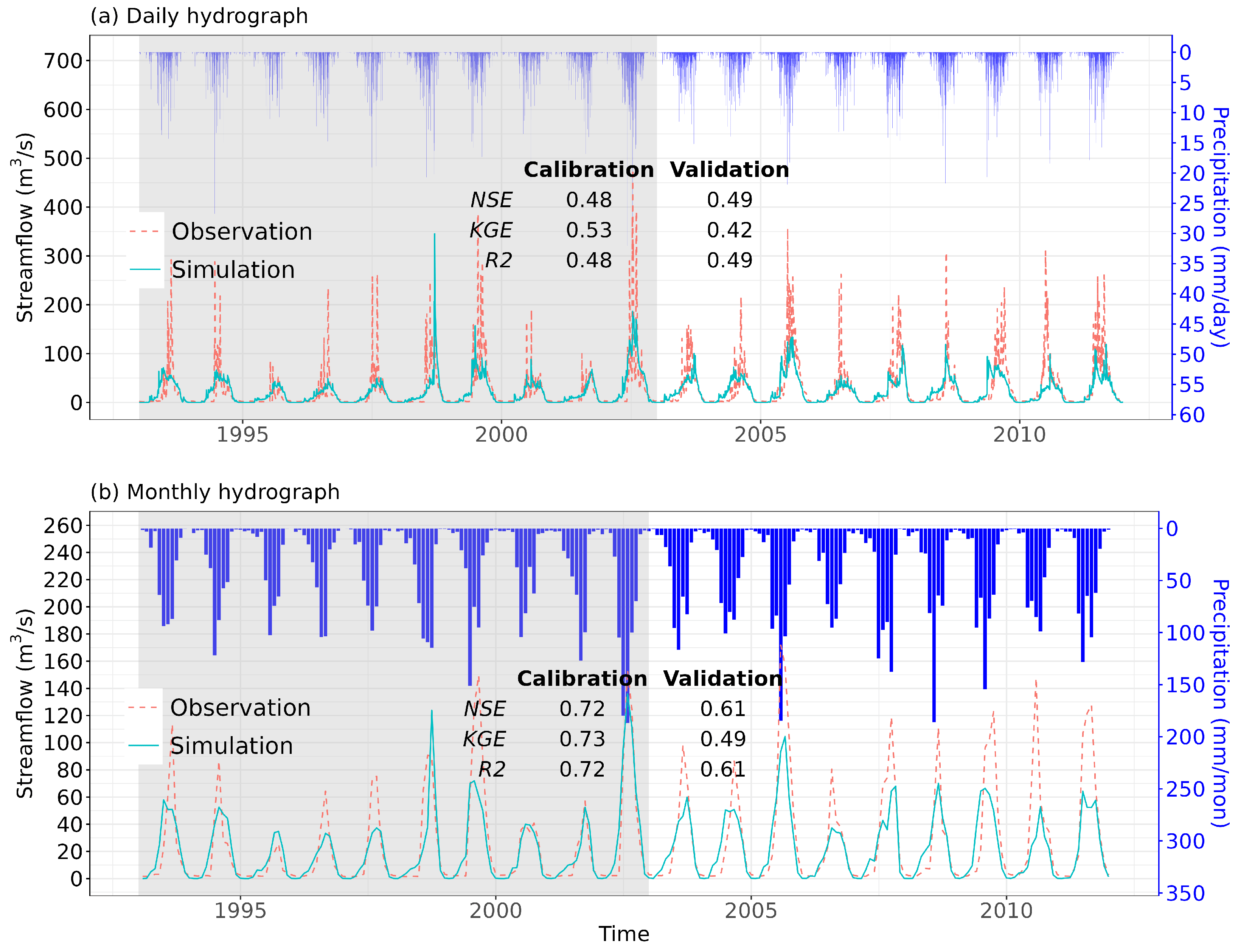

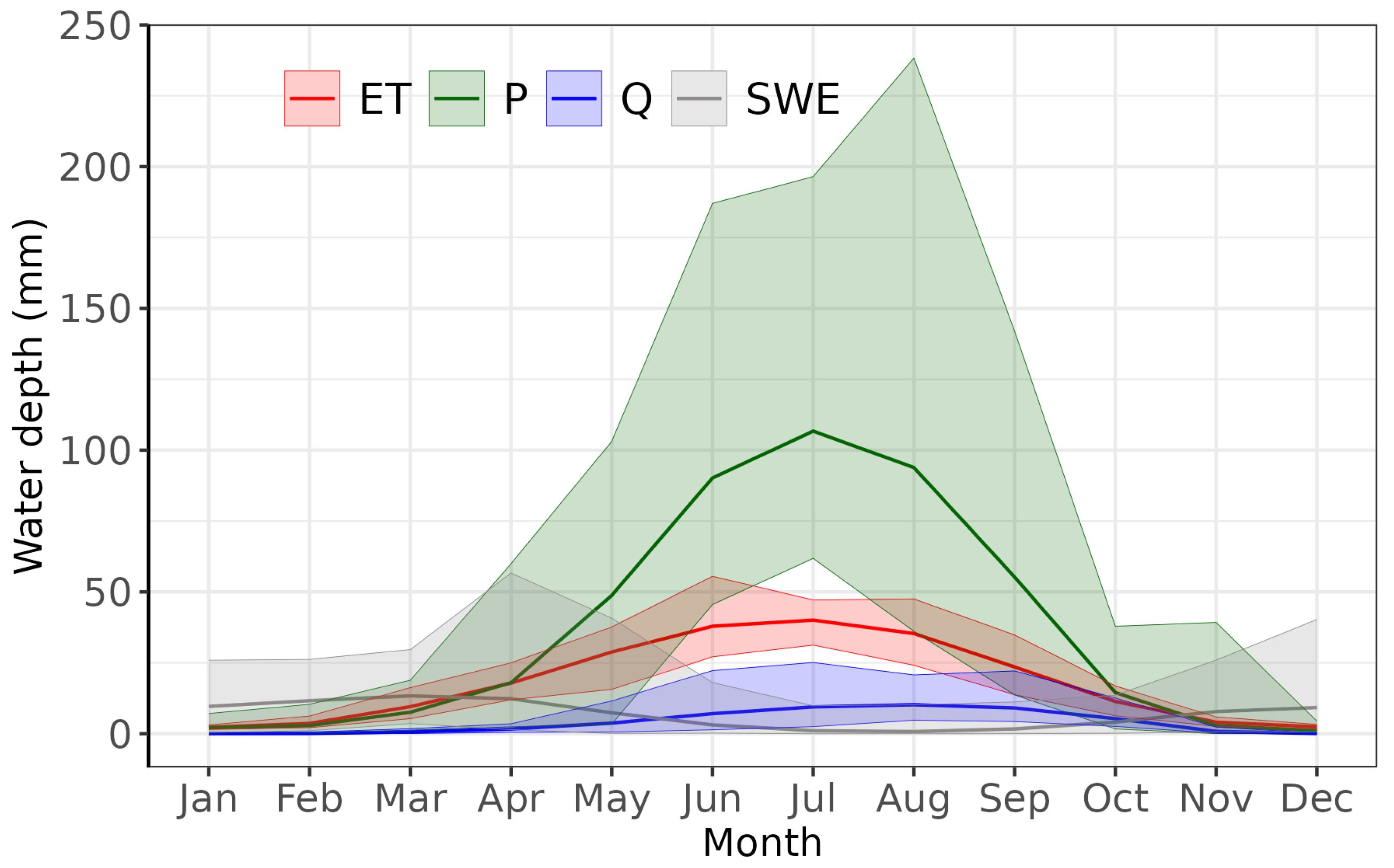
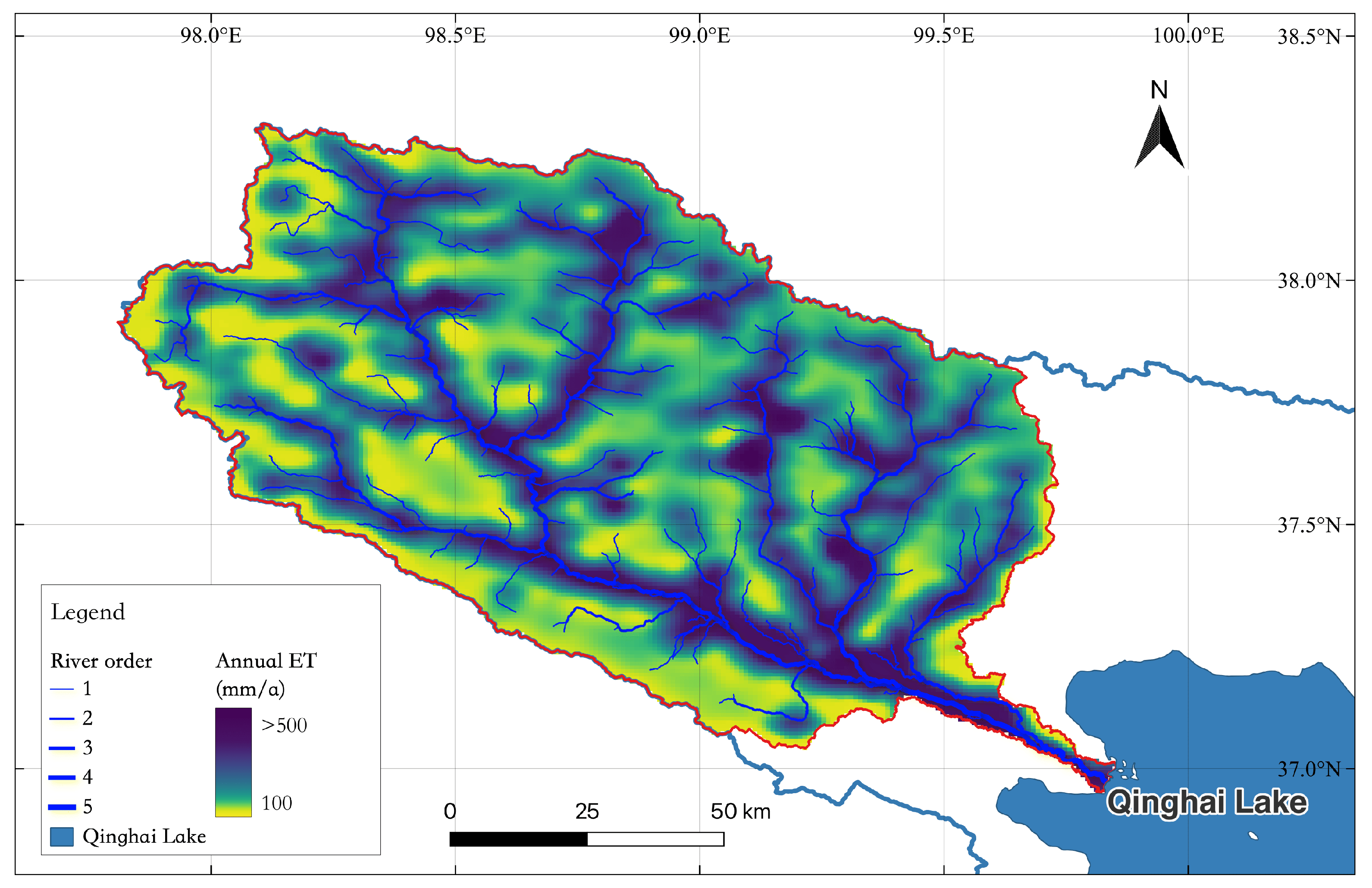
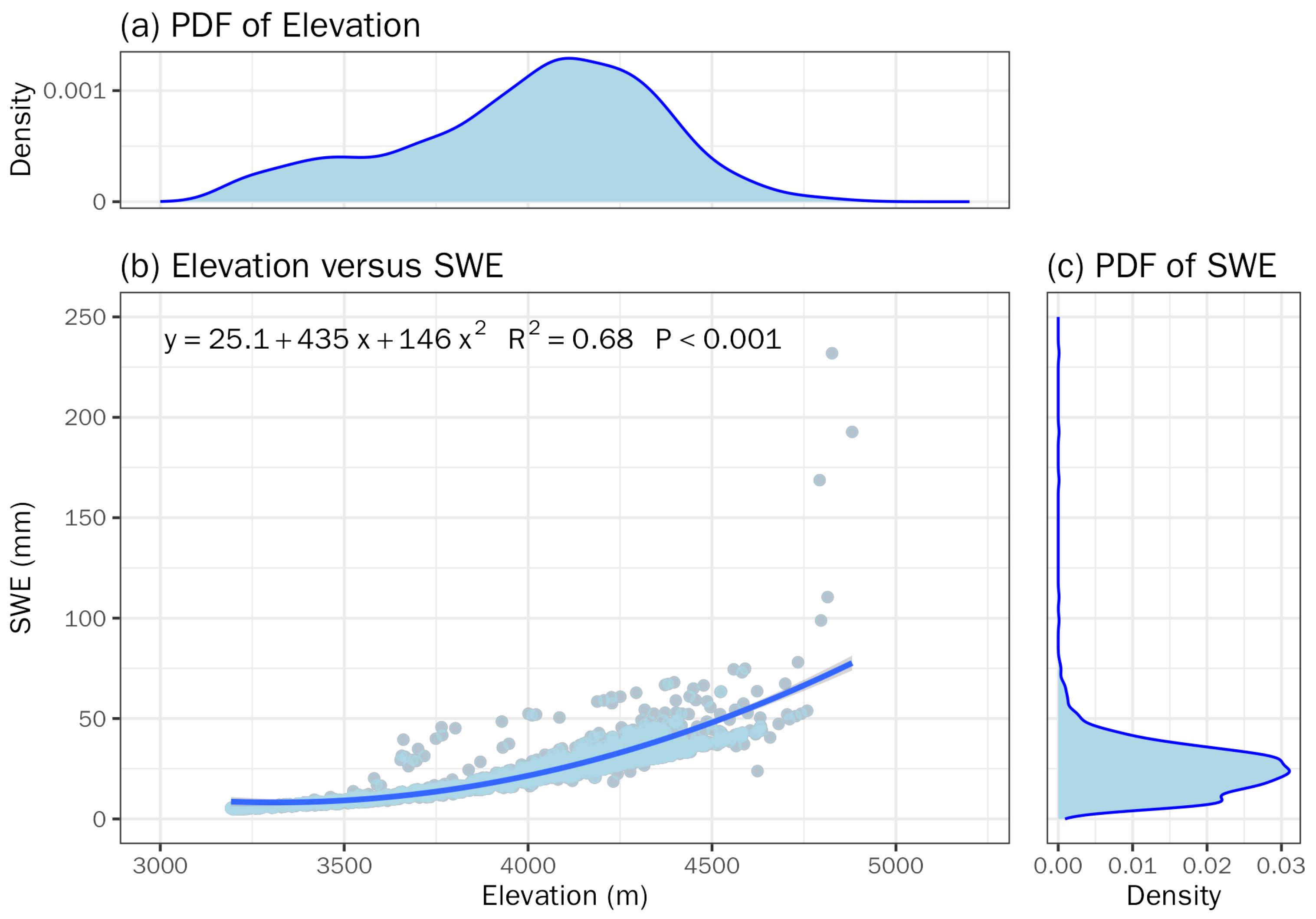

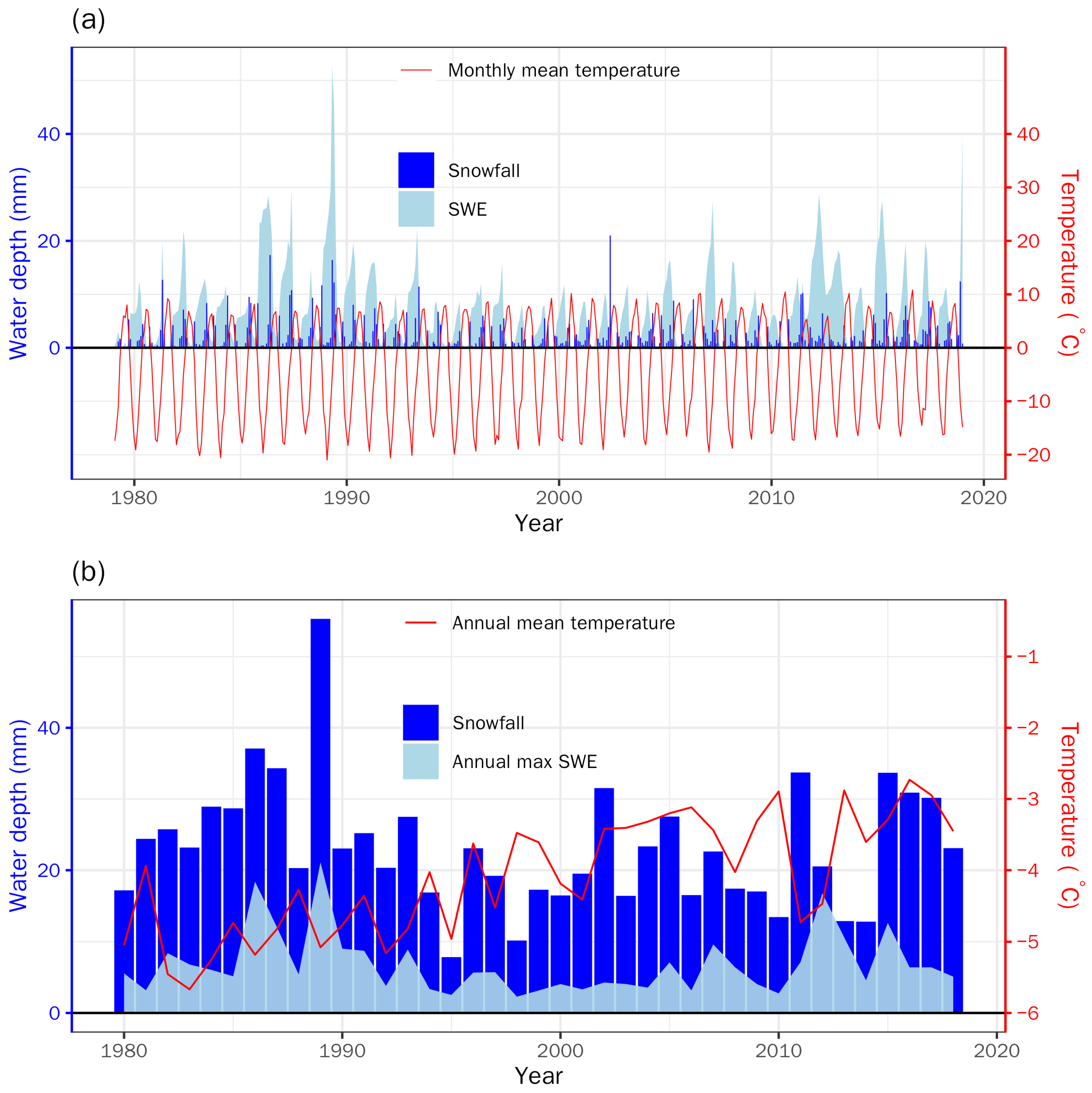
Disclaimer/Publisher’s Note: The statements, opinions and data contained in all publications are solely those of the individual author(s) and contributor(s) and not of MDPI and/or the editor(s). MDPI and/or the editor(s) disclaim responsibility for any injury to people or property resulting from any ideas, methods, instructions or products referred to in the content. |
© 2024 by the authors. Licensee MDPI, Basel, Switzerland. This article is an open access article distributed under the terms and conditions of the Creative Commons Attribution (CC BY) license (https://creativecommons.org/licenses/by/4.0/).
Share and Cite
Chang, Y.; Li, X.; Shu, L.; Ji, H. Comprehensive Hydrological Analysis of the Buha River Watershed with High-Resolution SHUD Modeling. Water 2024, 16, 2015. https://doi.org/10.3390/w16142015
Chang Y, Li X, Shu L, Ji H. Comprehensive Hydrological Analysis of the Buha River Watershed with High-Resolution SHUD Modeling. Water. 2024; 16(14):2015. https://doi.org/10.3390/w16142015
Chicago/Turabian StyleChang, Yan, Xiaodong Li, Lele Shu, and Haijuan Ji. 2024. "Comprehensive Hydrological Analysis of the Buha River Watershed with High-Resolution SHUD Modeling" Water 16, no. 14: 2015. https://doi.org/10.3390/w16142015







